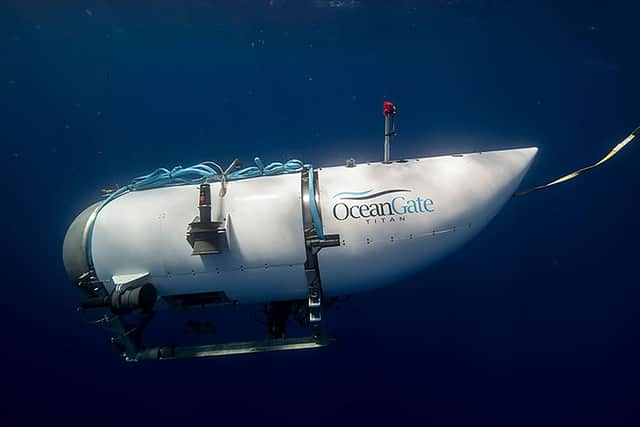Missing Titanic sub: ‘Debris field’ found within search area for OceanGate’s Titan, US Coast Guard says
A debris field near the Titanic has been found by a remotely controlled underwater vehicle within the search area for the missing sub, according to the US Coast Guard. Experts are now analysing the findings.
It comes hours after it was forecast the submersible’s air supply would run out around 12.08pm UK time on Thursday. OceanGate’s Titan was reported overdue on Sunday evening (18 June) while carrying a crew down to the wreck of the Titanic, about 435 miles off the Canadian coast.
Advertisement
Hide AdAdvertisement
Hide AdOn Tuesday evening UK time, the US Coast Guard said they have roughly 40 hours of breathable air left, as the "complex" and "unusual" search and recovery operation continues.
The US Coast Guard tweeted on Thursday afternoon: (June 22): “A debris field was discovered within the search area by an ROV near the Titanic. Experts within the unified command are evaluating the information.”
Rescuers searched a remote stretch of the Atlantic Ocean more than twice the size of the US state of Connecticut in waters as deep as 4,020m (13,200ft) with ships, planes, and submersible craft from numerous countries.
The five individuals on board were British billionaire Hamish Harding, British businessman Shahzada Dawood, his son Suleman Dawood, OceanGate’s US-based chief executive and founder Stockton Rush, and French submersible pilot Paul-Henri Nargeolet.
Advertisement
Hide AdAdvertisement
Hide AdA news conference is expected to take place around 8pm UK time.
The Titan was a manned submersible designed and built by OceanGate, capable of carrying up to five people to depths of 4,000 meters “for site survey and inspection, research and data collection, film and media production, and deep sea testing of hardware and software”.


The company claims in its promotional material: “Once depth validation is complete, Titan will be the only privately owned submersible in the world capable of diving to 4,000 meters. Its operational depth would allow access to up to half of the world’s oceans.
A diagram labelled "typical seating configuration" showed how five people could fit on the vessel at once, with only one person being able to completely extend their legs at a time.
Advertisement
Hide AdAdvertisement
Hide AdBuilt from lightweight titanium and carbon fibre, Titan was intended to be "the most mobile and advanced deep-sea manned submersible in the world," according to OceanGate. Among deep diving submersibles, it has "the largest viewport" and "state-of-the-art lighting systems, as well as internally and externally mounted 4K video and photographic equipment."
According to OceanGate, there is "ample space for additional monitoring, inspection, and data collection equipment" inside. Its specs say the ship had dimensions of 6.7 by 2.8 by 2.5 metres, weighed 11,340 kilogrammes, and had a carrying capacity of 1,043 kilogrammes. Its 96 hours of life support for a crew of five was crucial.
With a speed of 3 knots (3.5km) per hour and, it was not tethered to the surface unlike many other water vehicles, and Titan was travelling independently in the water. An implosion could occur if any part of the submersible’s carbon fibre and titanium hull has suffered a small crack or fault. The implosion itself looks like a bubble which is created by the weight of the water.
Earlier, a medical team went to the site of the Titanic submersible rescue effort with medical equipment including a hyperbaric recompression chamber that can hold as many as six people. The Canadian Navy ship HMCS Glace Gay arrived about two hours after rescuers believe the 96-hour oxygen supply depleted.
Advertisement
Hide AdAdvertisement
Hide AdThe medical team specialises in dive medicine, according to an official from the Joint Rescue Coordination Centre Halifax of the Canadian Armed Forces. It said: “JRCC Halifax continues to assist MRCC (Maritime Rescue Coordination Centre) Boston in support of submarine search efforts,’ Lt. Cmdr. Len Hickey, senior public affairs officer.”
There are also three Canadian Coast Guard ships were also on the scene.
Comment Guidelines
National World encourages reader discussion on our stories. User feedback, insights and back-and-forth exchanges add a rich layer of context to reporting. Please review our Community Guidelines before commenting.
